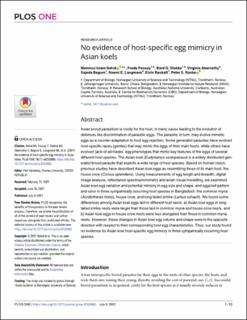| dc.contributor.author | Nahid, Mominul Islam | |
| dc.contributor.author | Fossøy, Frode | |
| dc.contributor.author | Stokke, Bård Gunnar | |
| dc.contributor.author | Abernathy, Virginia | |
| dc.contributor.author | Begum, Sajeda | |
| dc.contributor.author | Langmore, Naomi E. | |
| dc.contributor.author | Røskaft, Eivin | |
| dc.contributor.author | Ranke, Peter Sjolte | |
| dc.date.accessioned | 2022-10-26T09:39:24Z | |
| dc.date.available | 2022-10-26T09:39:24Z | |
| dc.date.created | 2021-08-02T11:54:48Z | |
| dc.date.issued | 2021 | |
| dc.identifier.citation | PLOS ONE. 2021, 16 (7), . | en_US |
| dc.identifier.issn | 1932-6203 | |
| dc.identifier.uri | https://hdl.handle.net/11250/3028369 | |
| dc.description.abstract | Avian brood parasitism is costly for the host, in many cases leading to the evolution of defenses like discrimination of parasitic eggs. The parasite, in turn, may evolve mimetic eggs as a counter-adaptation to host egg rejection. Some generalist parasites have evolved host-specific races (gentes) that may mimic the eggs of their main hosts, while others have evolved ‘jack-of-all-trades’ egg phenotypes that mimic key features of the eggs of several different host species. The Asian koel (Eudynamys scolopaceus) is a widely distributed generalist brood parasite that exploits a wide range of host species. Based on human vision, previous studies have described Asian koel eggs as resembling those of its main host, the house crow (Corvus splendens). Using measurements of egg length and breadth, digital image analysis, reflectance spectrophotometry and avian visual modelling, we examined Asian koel egg variation and potential mimicry in egg size and shape, and eggshell pattern and color in three sympatrically occurring host species in Bangladesh: the common myna (Acridotheres tristis), house crow, and long-tailed shrike (Lanius schach). We found some differences among Asian koel eggs laid in different host nests: a) Asian koel eggs in longtailed shrike nests were larger than those laid in common myna and house crow nests, and b) Asian koel eggs in house crow nests were less elongated than those in common myna nests. However, these changes in Asian koel egg volume and shape were in the opposite direction with respect to their corresponding host egg characteristics. Thus, our study found no evidence for Asian koel host-specific egg mimicry in three sympatrically occurring host species. | en_US |
| dc.language.iso | eng | en_US |
| dc.publisher | PLOS | en_US |
| dc.rights | Navngivelse 4.0 Internasjonal | * |
| dc.rights.uri | http://creativecommons.org/licenses/by/4.0/deed.no | * |
| dc.title | No evidence of host-specific egg mimicry in Asian koels | en_US |
| dc.title.alternative | No evidence of host-specific egg mimicry in Asian koels | en_US |
| dc.type | Peer reviewed | en_US |
| dc.type | Journal article | en_US |
| dc.description.version | publishedVersion | en_US |
| dc.subject.nsi | VDP::Zoologiske og botaniske fag: 480 | en_US |
| dc.subject.nsi | VDP::Zoology and botany: 480 | en_US |
| dc.source.pagenumber | 22 | en_US |
| dc.source.volume | 16 | en_US |
| dc.source.journal | PLOS ONE | en_US |
| dc.source.issue | 7 | en_US |
| dc.identifier.doi | 10.1371/journal.pone.0253985 | |
| dc.identifier.cristin | 1923394 | |
| dc.relation.project | Norges forskningsråd: 223257 | en_US |
| cristin.ispublished | true | |
| cristin.fulltext | original | |
| cristin.qualitycode | 1 | |

